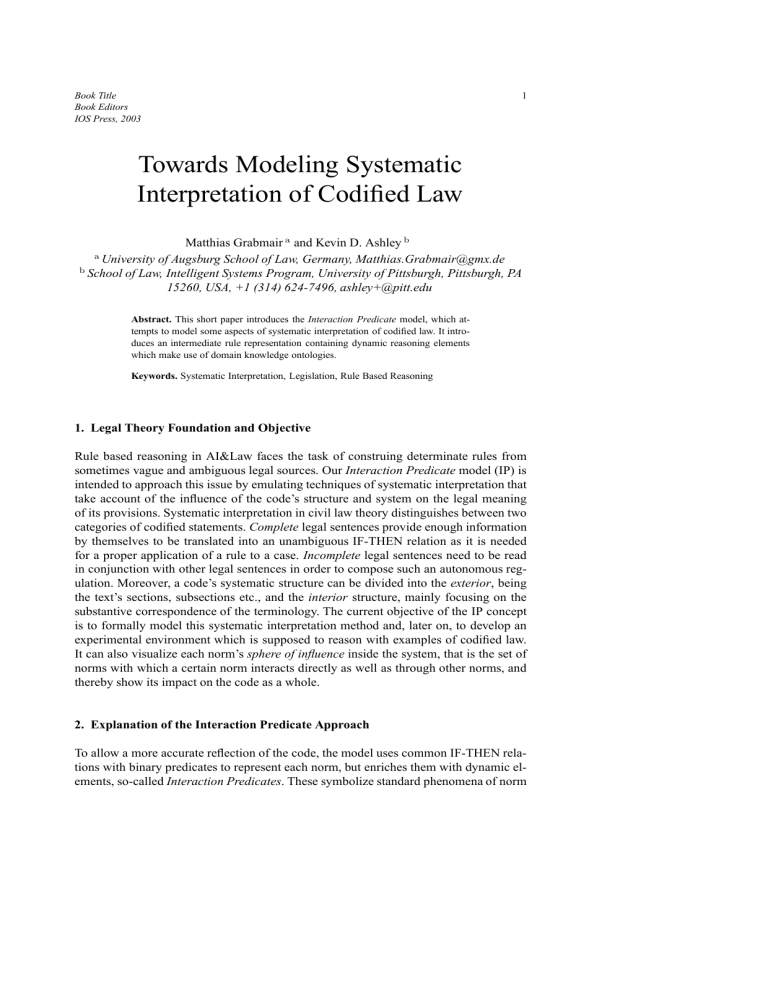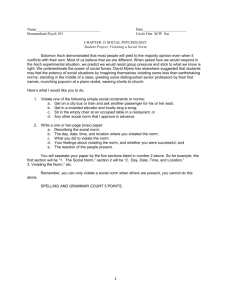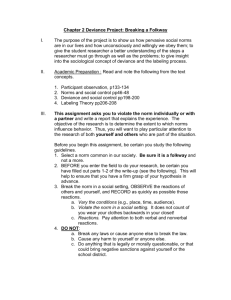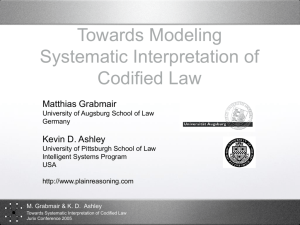Towards Modeling Systematic Interpretation of Codified Law

Book Title
Book Editors
IOS Press, 2003
Towards Modeling Systematic
Interpretation of Codified Law
Matthias Grabmair a and Kevin D. Ashley b a
University of Augsburg School of Law, Germany, Matthias.Grabmair@gmx.de
b
School of Law, Intelligent Systems Program, University of Pittsburgh, Pittsburgh, PA
15260, USA, +1 (314) 624-7496, ashley+@pitt.edu
Abstract. This short paper introduces the Interaction Predicate model, which attempts to model some aspects of systematic interpretation of codified law. It introduces an intermediate rule representation containing dynamic reasoning elements which make use of domain knowledge ontologies.
Keywords. Systematic Interpretation, Legislation, Rule Based Reasoning
1
1. Legal Theory Foundation and Objective
Rule based reasoning in AI&Law faces the task of construing determinate rules from sometimes vague and ambiguous legal sources. Our Interaction Predicate model (IP) is intended to approach this issue by emulating techniques of systematic interpretation that take account of the influence of the code’s structure and system on the legal meaning of its provisions. Systematic interpretation in civil law theory distinguishes between two categories of codified statements. Complete legal sentences provide enough information by themselves to be translated into an unambiguous IF-THEN relation as it is needed for a proper application of a rule to a case. Incomplete legal sentences need to be read in conjunction with other legal sentences in order to compose such an autonomous regulation. Moreover, a code’s systematic structure can be divided into the exterior, being the text’s sections, subsections etc., and the interior structure, mainly focusing on the substantive correspondence of the terminology. The current objective of the IP concept is to formally model this systematic interpretation method and, later on, to develop an experimental environment which is supposed to reason with examples of codified law.
It can also visualize each norm’s sphere of influence inside the system, that is the set of norms with which a certain norm interacts directly as well as through other norms, and thereby show its impact on the code as a whole.
2. Explanation of the Interaction Predicate Approach
To allow a more accurate reflection of the code, the model uses common IF-THEN relations with binary predicates to represent each norm, but enriches them with dynamic elements, so-called Interaction Predicates. These symbolize standard phenomena of norm
interaction and have reasoning algorithms attached to them, which are defined as the typical thinking steps a jurist takes when systematically interpreting the respective norm. In this intermediate norm representation (INR), every legal sentence of the original code has its own relation, so that the exterior system of the code is preserved. The interior system is captured by a set of domain knowledge ontologies, which interrelate the binary predicates and embed them in the overall legal construct. In the actual reasoning process, this
INR is translated into a tree of unambiguous IF-THEN rulesets, meaning rules which are free of interaction predicates. The IP reasoning algorithms use the domain ontologies to resolve interpretive issues and, whenever more than one legally plausible interpretation is determined, spread open the tree’s branches accordingly.
For example, a general norm n1 may order a legal consequence under a set of factual requirements r1, r2 and r3. A subsequent norm n2 provides that requirement r3 alone
"shall suffice" in case a fourth requirement r4 is present, but neither states n1’s consequence anew nor makes an explicit reference to it. The IP model will represent n2 by using the interaction predicate suffice as its consequence and enable it to determine n1 as the referenced norm by virtue of n2’s structural position relative to n1. It will take over
n1’s consequence for n2 and, by using domain knowledge, determine whether r3 and r4 really make both r1 and r2 obsolete or whether there is an implicit assumption that only one of them shall be disregarded while the other one remains required.
3. Related Research
The IP concept assumes that a piece of written law can principally be translated into a normalized INR set. De Maat and Van Engers are already developing an automated rule extraction model (de Maat & Van Engers [1]). The POWER project (Van Engers et. al.
[2]) included an anomaly detection framework which can spot inconsistencies in modeled legislation and prompt an expert for reviewal. By contrast, the IP model is conceptualized to resolve norm interaction conflicts by utilizing formalized legal methods.
4. Concluding Remarks
The Interaction Predicate approach tries to capture civil law legal reasoning more accurately by introducing an INR which neutrally preserves the sphere of influence of each norm in the context of the code and underlying domain knowledge. Its functionality depends on the definition of the IP algorithms, which may unnecessarily complicate undisputed issues. Still, we are convinced that experimental results can help sharpen the contours of legal methodology and contribute to norm interpretation research in AI&Law.
References
[1] E. de Maat & T. van Engers, Mission Impossible?: Automated Norm Analysis Of Legal Texts,
Jurix 2003: The Sixteenth Annual Conference - Legal Knowledge and Information Systems,
143-144 (D. Bourcier ed., IOS Press 2003).
[2] T. van Engers et al., POWER: Programme for an Ontology based Working Environment for
Modeling and Use of Regulations and Legislation, Proc. of the 11th Workshop on Databases and Expert Systems Applications (IEEE) 327-334 (Tjoa, Wagner, and Al-Zobaidie ed., 2000).







